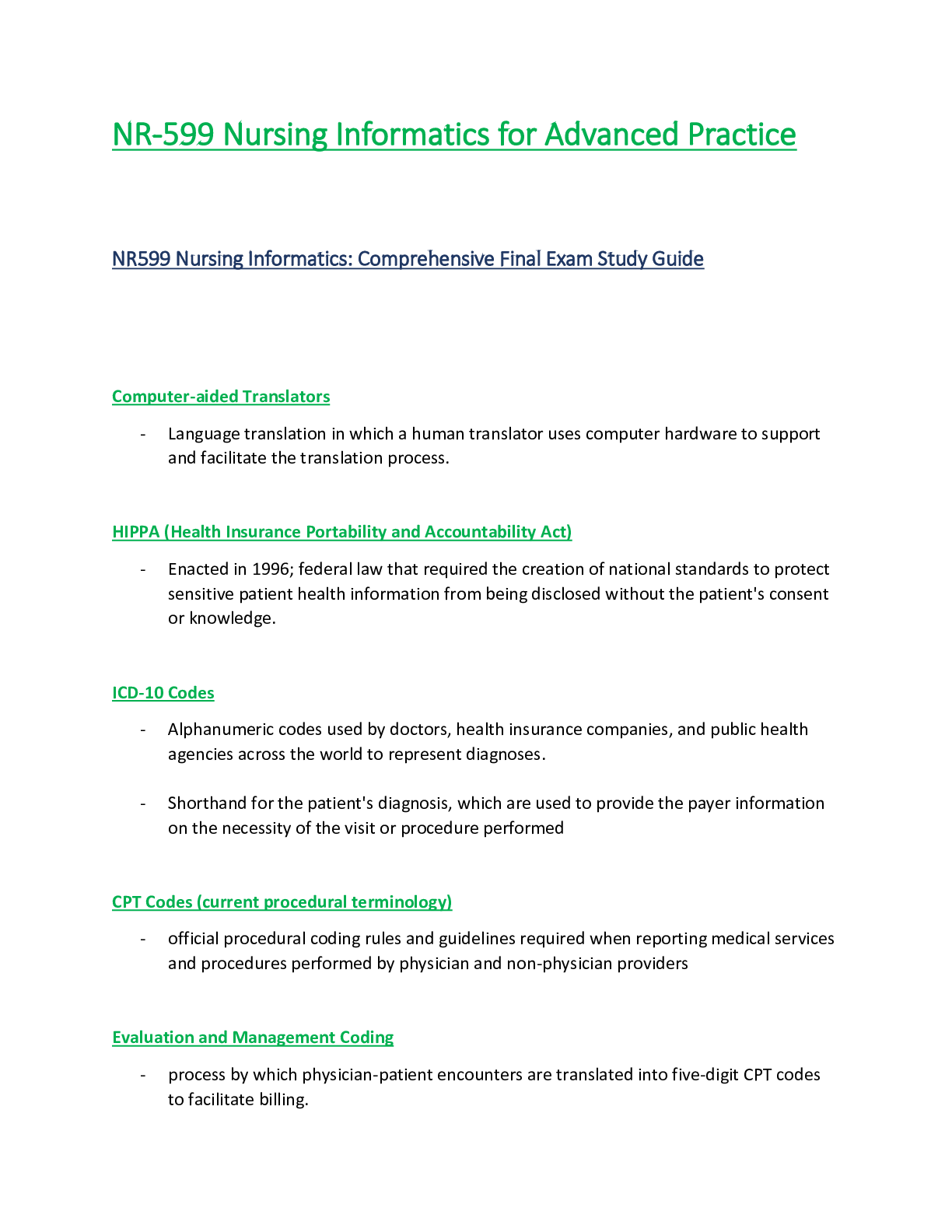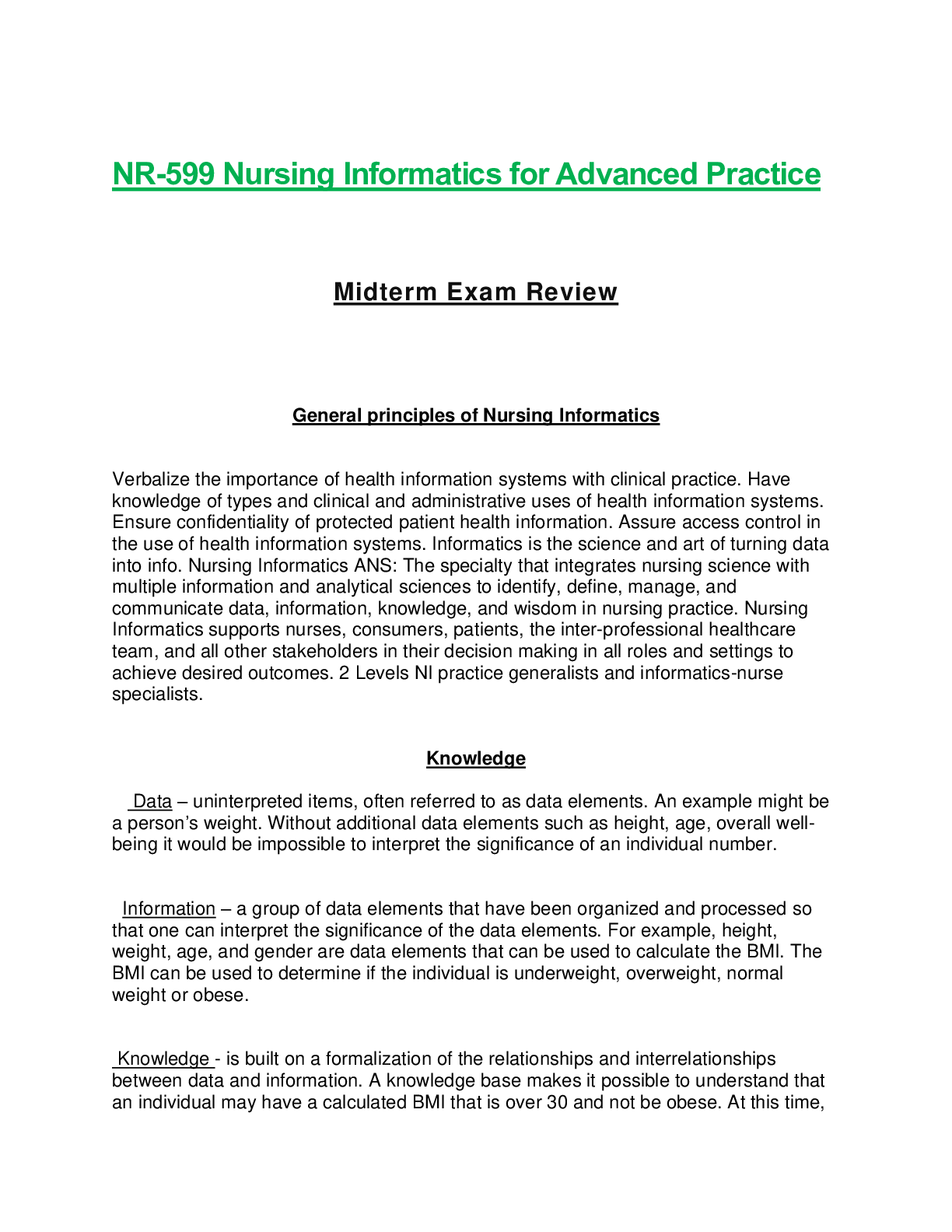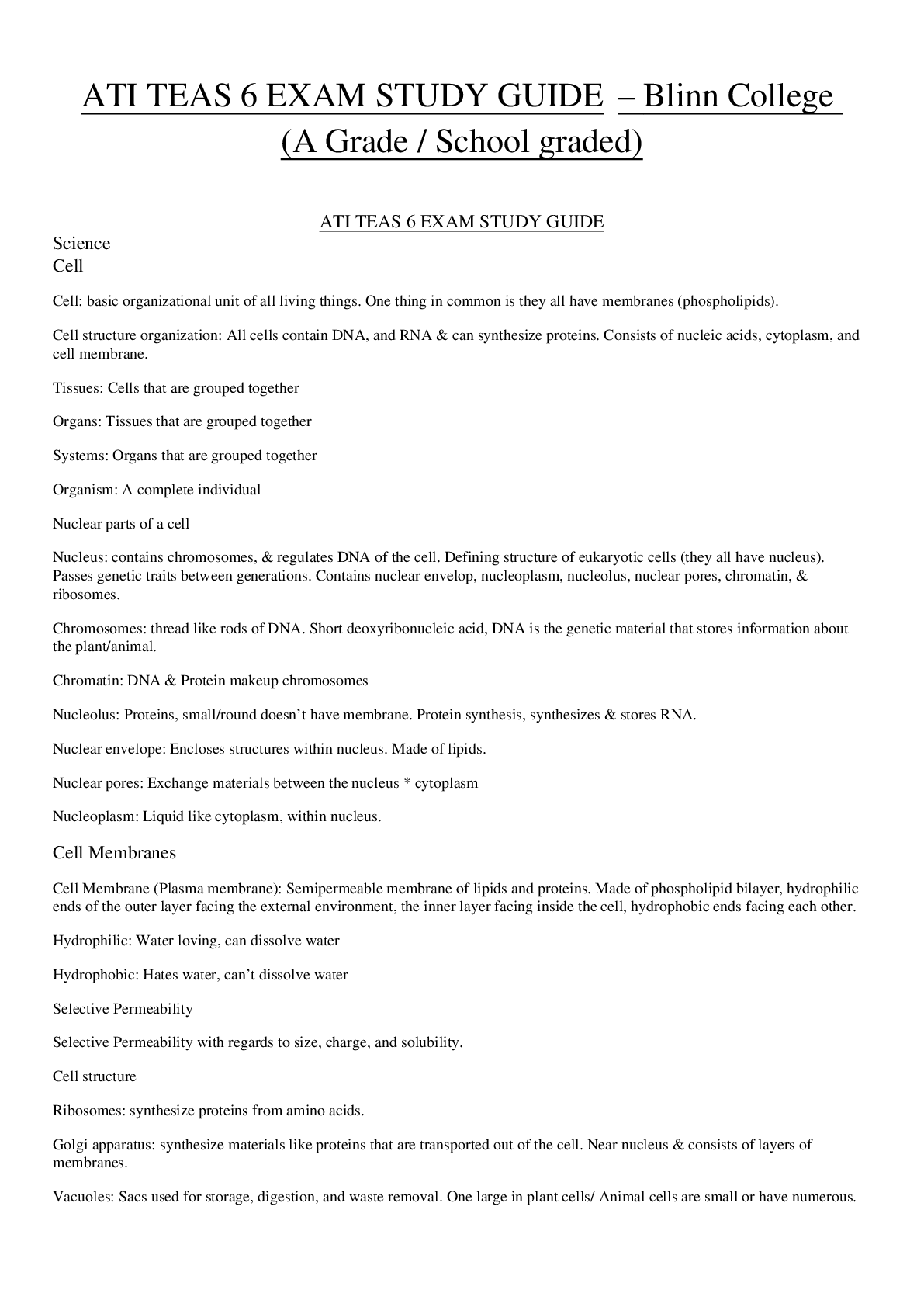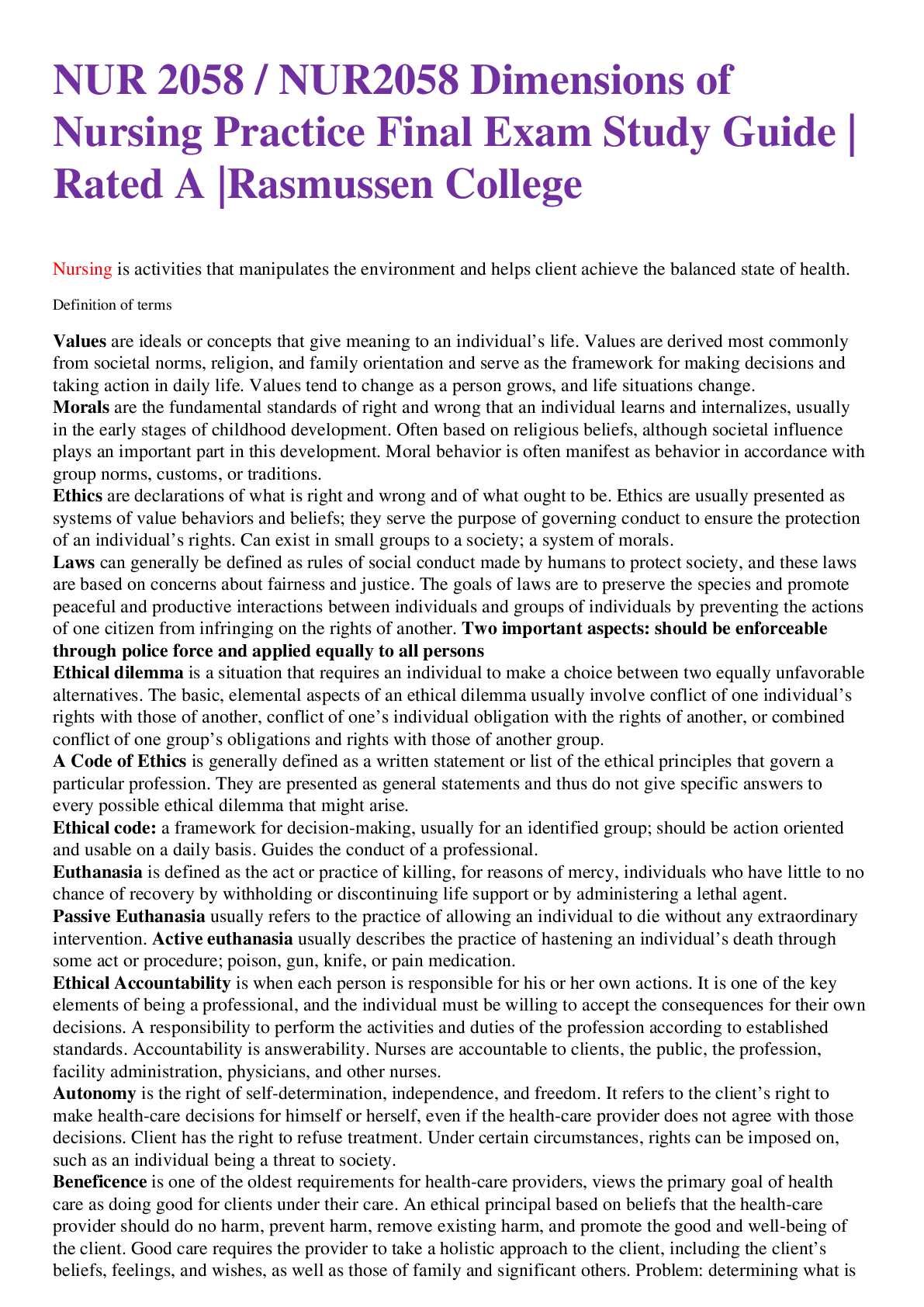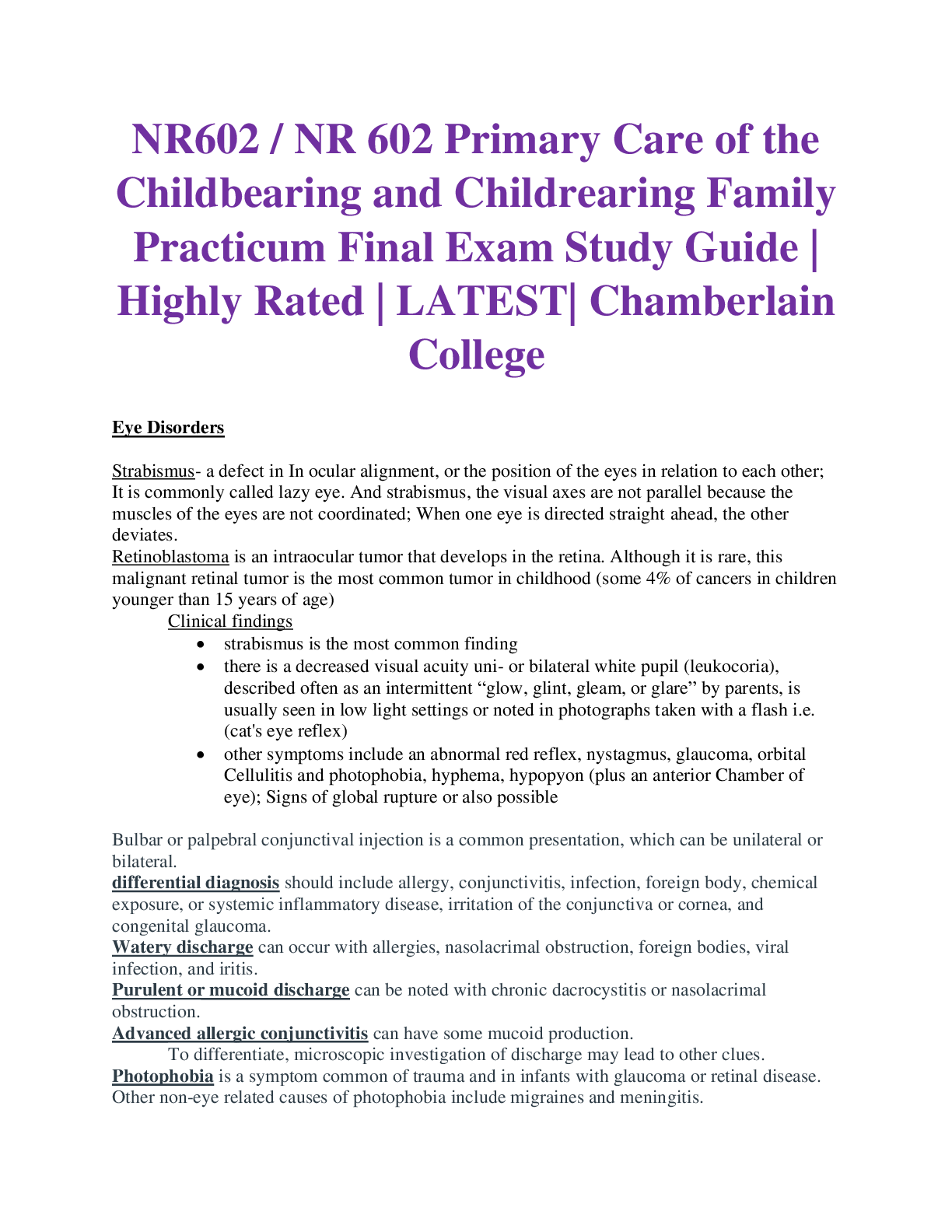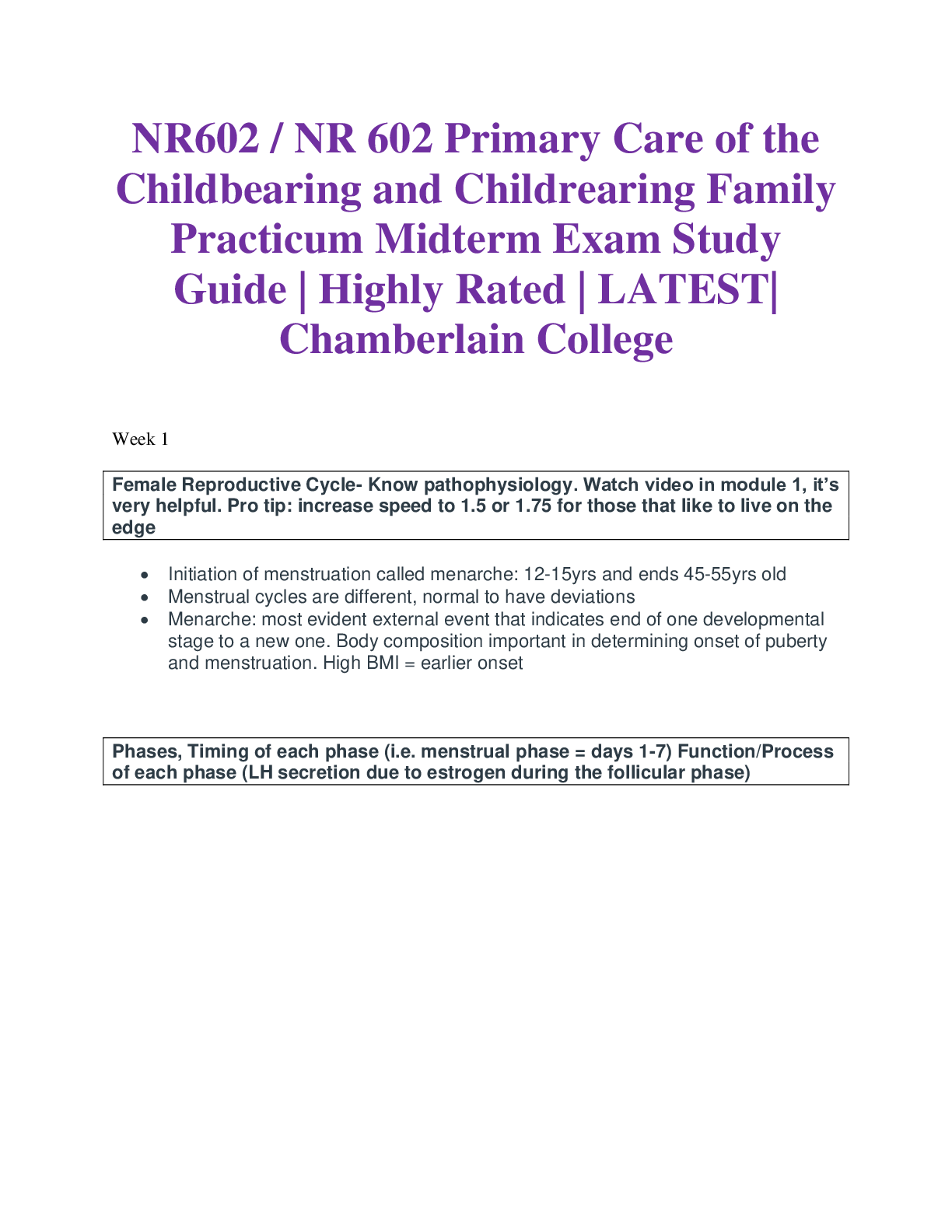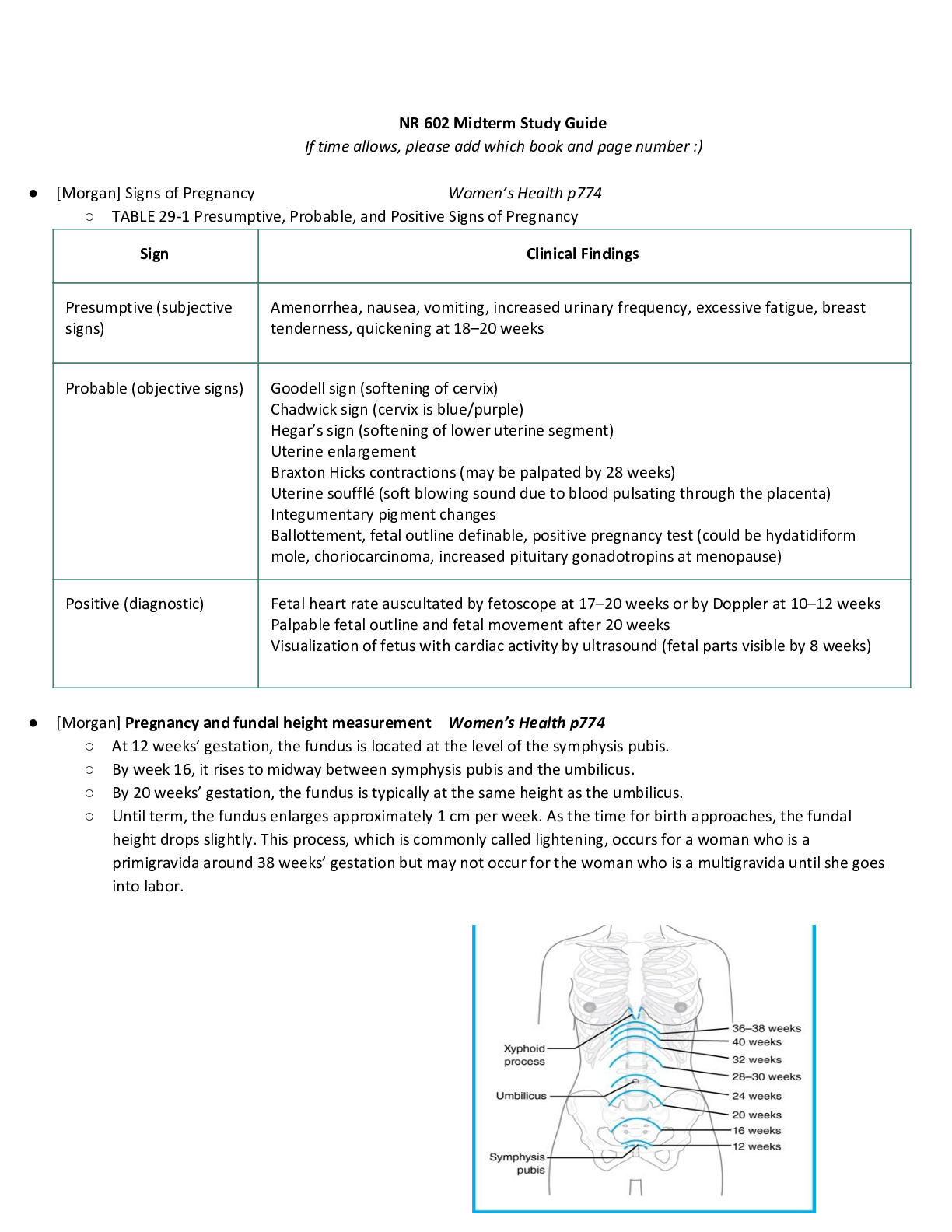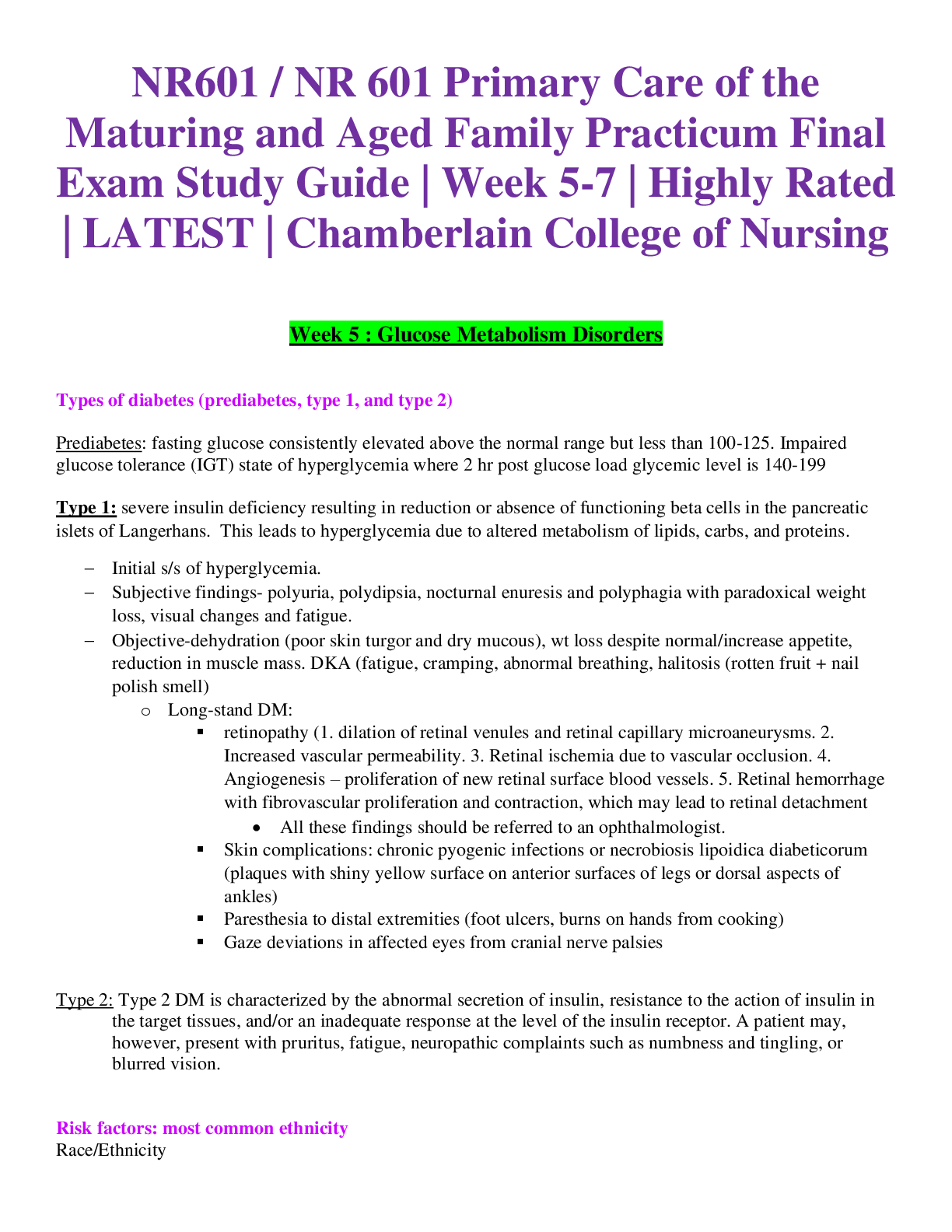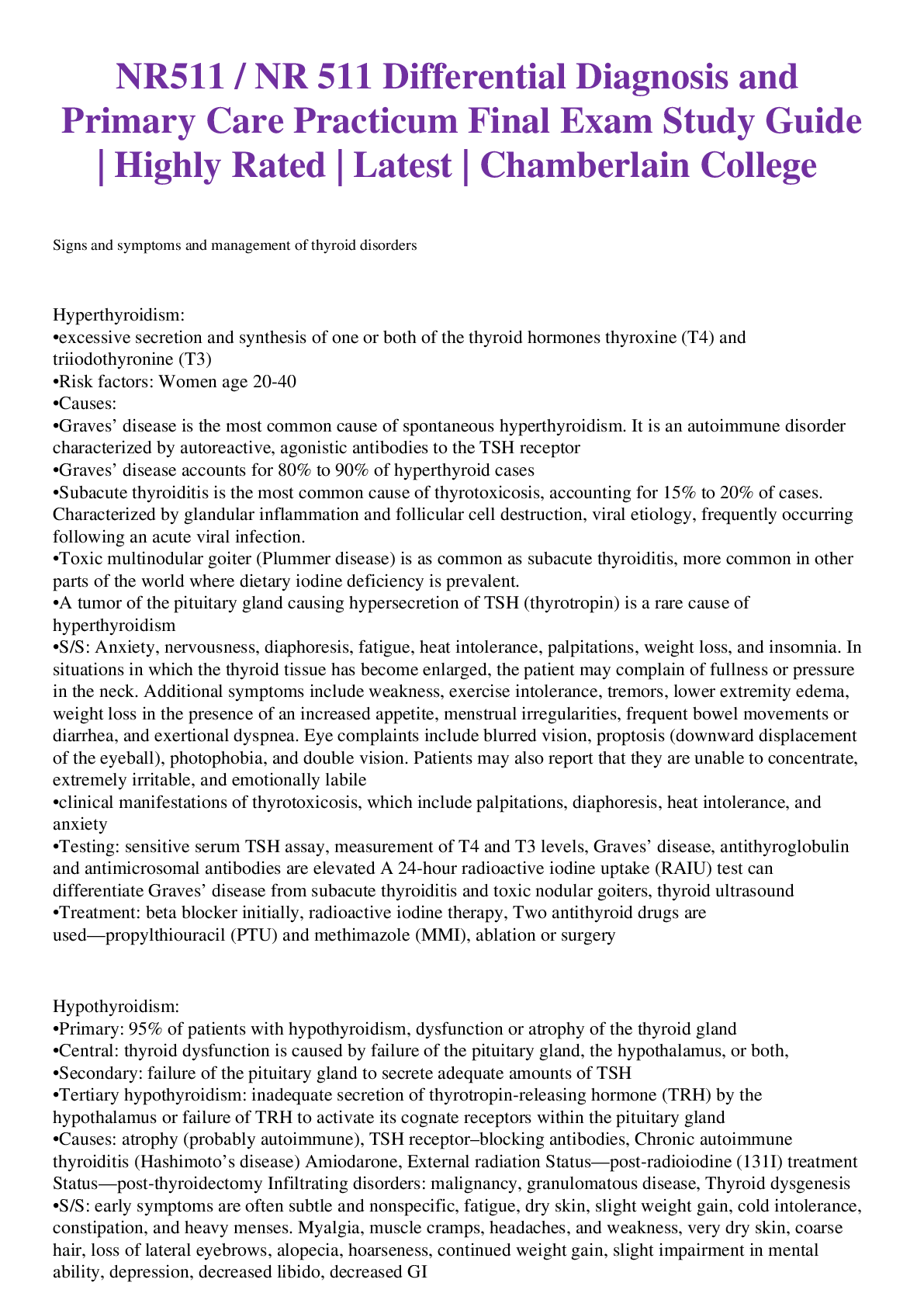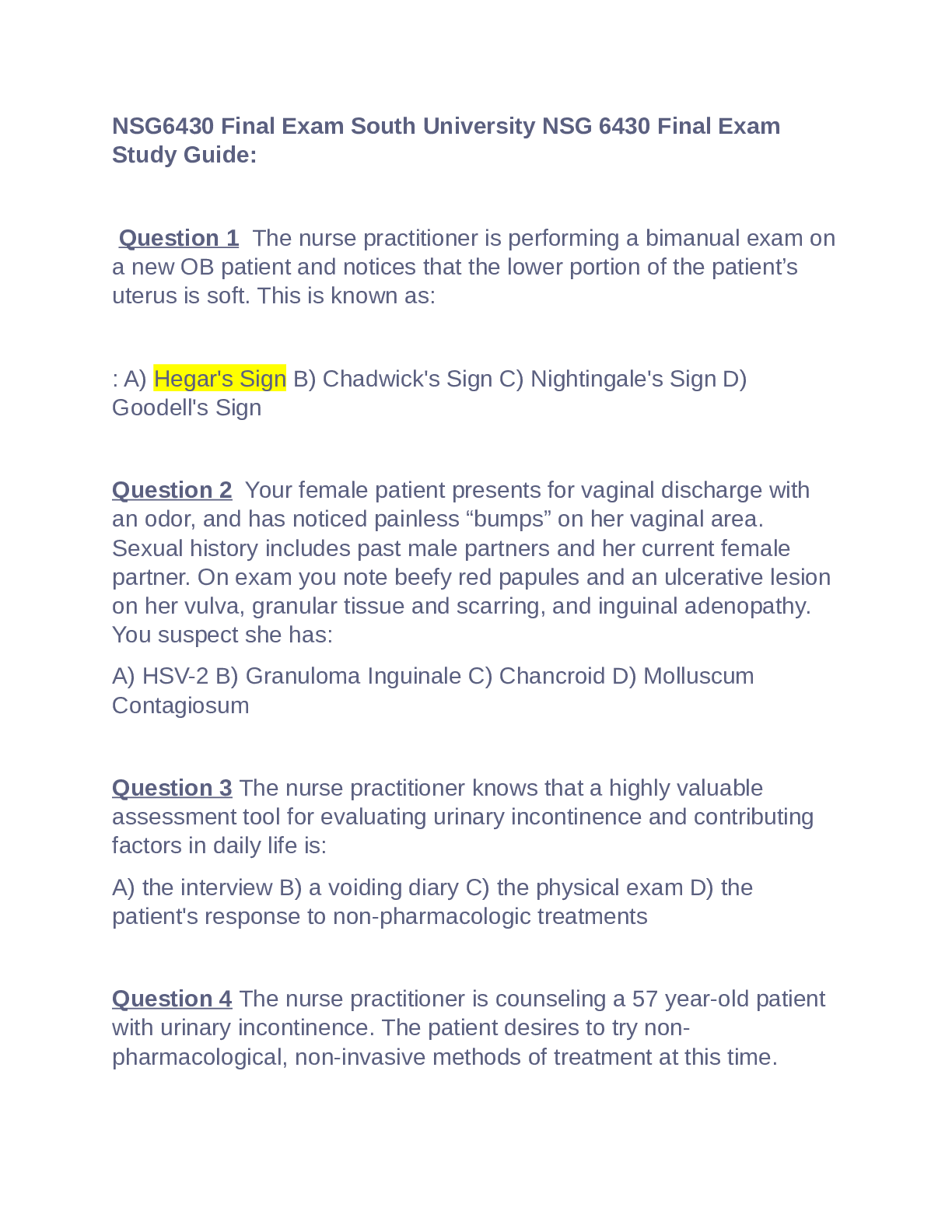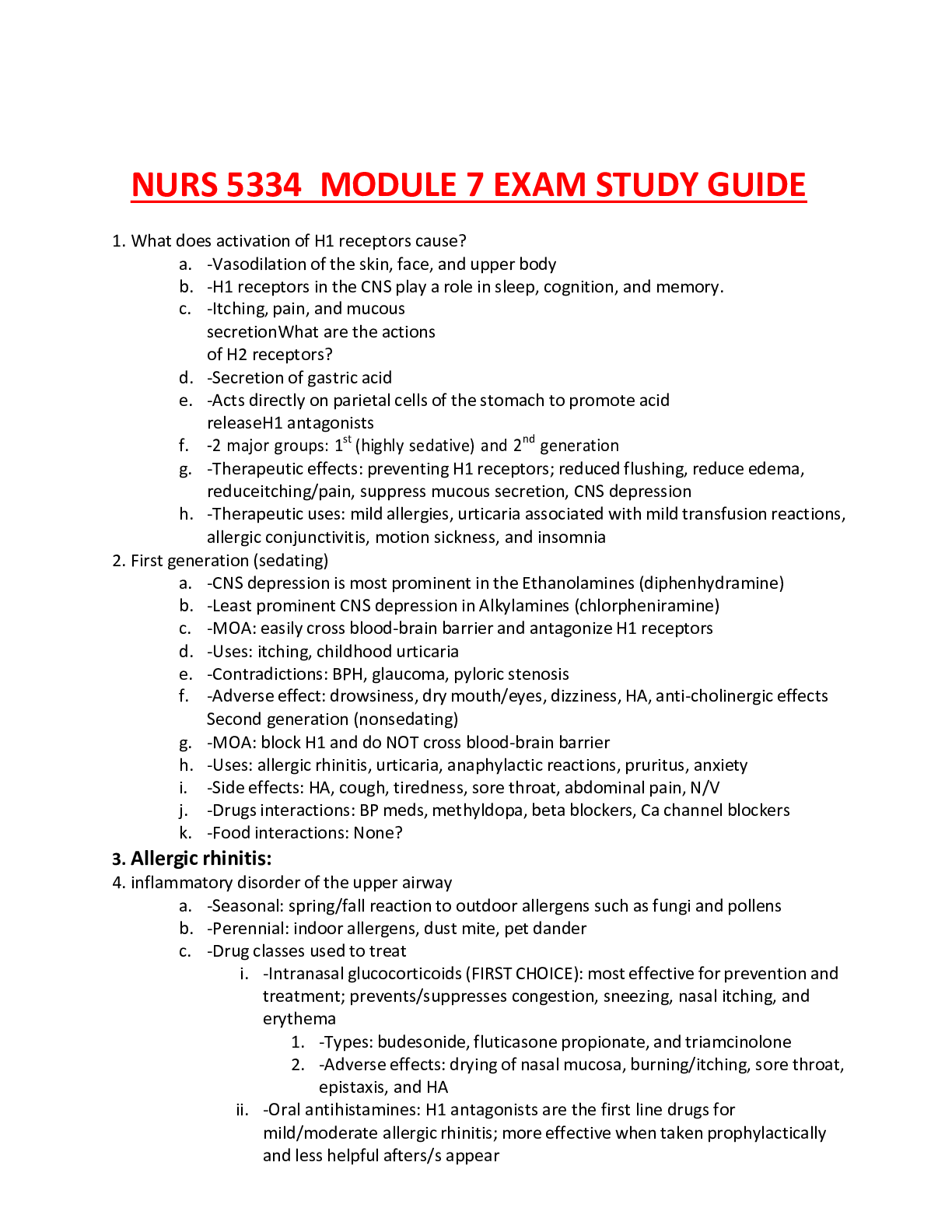Leadership & Management > STUDY GUIDE > LEADERSHIP AND MANAGEMENT ATI COMPREHENSIVE EXAM STUDY GUIDE QUESTIONS WITH ANSWERS 2024 (All)
LEADERSHIP AND MANAGEMENT ATI COMPREHENSIVE EXAM STUDY GUIDE QUESTIONS WITH ANSWERS 2024
Document Content and Description Below
LEADERSHIP AND MANAGEMENT ATI COMPREHENSIVE EXAM STUDY GUIDE QUESTIONS WITH ANSWERS 2024 1. Which is a rec- ommended guideline for safe computerized charting? 2... . The licensed practical nurse (LPN) enters a client's room and finds the client sitting on the floor. The LPN calls the registered nurse, who checks the client thor- oughly and then as- sists the client back into bed. The LPN com- pletes an incident re- port, and the nursing Passwords to the computer system should only be changed if lost. 2. Computer terminals may be left unattended during client-care activities. 3. Accidental deletions from the computerized file need to be reported to the nursing manager or supervisor. (correct) 4. Copies of printouts from computerized files should be kept on a clipboard at the nurses' station for other nurses to access. rationale: After any inadvertent deletions of perma- nent computerized records, the nurse should type an explanation into the computer file with the date, time, and his or her initials. The nurse should also contact the nursing manager or supervisor with a written explanation of the situation. Options 1, 2, and 4 represent unsafe charting actions. Only option 3 follows the guidelines for safe computer charting. Place the incident report in the client's chart. 2. Make a copy of the incident report for the HCP. 3. Document a complete entry in the client's record concerning the incident. (correct) 4. Document in the client's record that an incident report has been completed supervisor and health care provider (HCP) are notified of the inci- dent. Which is the next nursing action regard- ing the incident? RATIONALE: The incident report is confidential and privileged information, and it should not be copied, placed in the chart, or have any reference made to it in the client's record. The incident report is not a substitute for a complete entry in the client's record concerning the incident. 3. An unconscious client, Call the nursing supervisor to initiate a court order bleeding profusely, is brought to the emer- gency department af- ter a serious accident. Surgery is required im- mediately to save the client's life. With re- gard to informed con- sent for the surgical procedure, which is the best action? 4. The nurse arrives at work and is told to re- port (float) to the pe- diatric unit for the day because the unit is un- for the surgical procedure. 2. Try calling the client's spouse to obtain telephone consent before the surgical procedure. 3. Ask the friend who accompanied the client to the emergency department to sign the consent form. 4. Transport the client to the operating department im- mediately, as required by the health care provider, without obtaining an informed consent. (COR- RECT) RATIONALE: Generally there are only two in- stances in which the informed consent of an adult client is not needed. One instance is when an emer- gency is present and delaying treatment for the purpose of obtaining informed consent would result in injury or death to the client. The second instance is when the client waives the right to give informed consent. Options 1, 2, and 3 are inappropriate . Call the hospital lawyer. 2. Call the nursing supervisor. derstaffed and needs additional nurses to care for the clients. The nurse has never worked in the pediatric unit. Which is the ap- propriate nursing ac- tion? 5. The nurse enters a client's room and notes that the client's lawyer is present and that the client is preparing a living will. The living will requires that the client's sig- nature be witnessed, and the client asks the nurse to witness the signature. Which is the appropriate nurs- ing action? 6. 3. Refuse to float to the pediatric unit. 4. Report to the pediatric unit and identify tasks that can be safely performed (correct) RATIONALE: Floating is an acceptable legal prac- tice used by hospitals to solve their understaffing problems. Legally the nurse cannot refuse to float unless a union contract guarantees that the nurse can only work in a specified area or the nurse can prove a lack of knowledge for the performance of assigned tasks. When faced with this situation, the nurse should identify potential areas of harm to the client Decline to sign the will. (CORRECT) 2. Sign the will as a witness to the signature only. 3. Call the hospital lawyer before signing the will. 4. Sign the will, clearly identifying credentials and em- ployment agency. RATIONALE: Living wills are required to be in writ- ing and signed by the client. The client's signature either must be witnessed by specified individuals or notarized. Many states prohibit any employee from being a witness, including the nurse in a facility in which the client is receiving care. The nurse finds the roviding clients with necessary stabilizing treat- client lying on the floor. ments The nurse calls the registered nurse, who checks the client and then calls the nurs- ing supervisor and the health care provider to inform them of the occurrence. The nurse completes the incident report for which pur- pose? 7. The nurse observes that a client received pain medication 1 hour ago from an- other nurse, but the client still has se- vere pain. The nurse has previously ob- served this same oc- currence. Based on the nurse practice act, the observing nurse should plan to take which action? 2. A method of promoting quality care and risk man- agement (correct) 3. Determining the effectiveness of interventions in relation to outcomes 4. The appropriate method of reporting to local, state, and federal agencies RATIONALE: Proper documentation of unusual oc- currences, incidents, accidents, and the nursing ac- tions taken as a result of the occurrence are internal to the institution or agency. Documentation on the incident report allows the nurse and administration to review the quality of care and determine any potential risks present. Options 1, 3, and 4 are incorrect. Report the information to the police. 2. Call the impaired nurse organization. 3. Talk with the nurse who gave the medication. 4. Report the information to a nursing supervisor. (CORRECT) RATIONALE: Nurse practice acts require reporting the suspicion of impaired nurses. The state board of nursing has jurisdiction over the practice of nurs- 8. A nurse lawyer pro- vides an education session to the nursing staff regarding client rights. The nurse asks the lawyer to describe an example that may relate to invasion of client privacy. Which nursing action indi- cates a violation of client privacy? 9. An older woman is brought to the emer- gency department. When caring for the client, the nurse notes old and new ecchymot- ic areas on both of the client's arms and buttocks. The nurse asks the client how the bruises were sus- tained. The client, al- ing and may develop plans for treatment and su- pervision. This suspicion needs to be reported to the nursing supervisor, who will then report to the board of nursing. Options 1 and 2 are inappropriate. Option 3 may cause a conflict. Threatening to place a client in restraints 2. Performing a surgical procedure without consent 3. Taking photographs of the client without consent (CORRECT) 4. Telling the client that he or she cannot leave the hospital RATIONALE: Invasion of privacy takes place when an individual's private affairs are intruded on unrea- sonably. Threatening to place a client in restraints constitutes assault. Performing a surgical proce- dure without consent is an example of battery. Not allowing a client to leave the hospital constitutes false imprisonment I have a legal obligation to report this type of abuse." (CORRECT) 2. "I promise I won't tell anyone, but let's see what we can do about this." 3. "Let's talk about ways that will prevent your daugh- ter from hitting you." 4. though reluctant, tells the nurse in confi- dence that her daugh- ter frequently hits her if she gets in the way. Which is the appropri- ate nursing response? 10. The nurse is recording a nursing hands-off (end-of-shift) report for a client. Which infor- mation needs to be in- cluded? "This should not be happening. If it happens again, you must call the emergency department." RATIONALE: Confidential issues are not to be discussed with nonmedical personnel or with the client's family or friends without the client's permis- sion. Clients should be assured that information is kept confidential unless it places the nurse under a legal obligation. The nurse must report situa- tions related to child, older adult abuse, and other types of abuse, depending on state laws; gunshot wounds; stabbings; and certain infectious diseases. As-needed medications given that shift (correct) 2. Normal vital signs that have been normal since admission 3. All of the tests and treatments the client has had since admission 4. Total number of scheduled medications that the client received on that shift RATIONALE: The nursing hands-off (end-of-shift) report needs to be an efficient and accurate ac- count of the client's condition during the last shift. It needs to include pertinent information about the client, such as tests and treatments; as-needed medications given or therapies performed during the past 24 hours, including the client's response to them; changes in the client's condition; sched- uled tests and treatments; current problems; and any other special concerns. It is not necessary to [Show More]
Last updated: 4 months ago
Preview 1 out of 116 pages
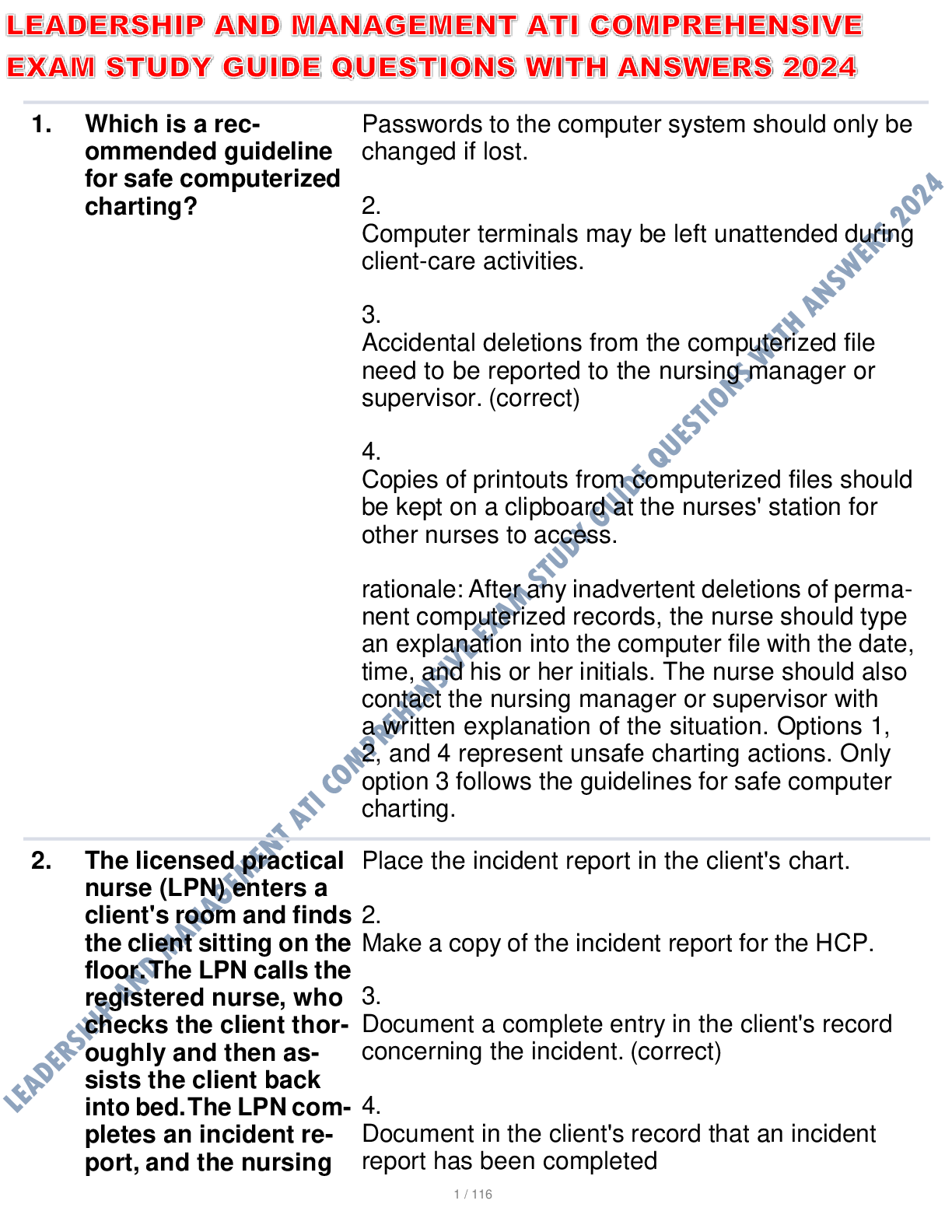
Reviews( 0 )
Document information
Connected school, study & course
About the document
Uploaded On
Jan 12, 2024
Number of pages
116
Written in
Additional information
This document has been written for:
Uploaded
Jan 12, 2024
Downloads
0
Views
12

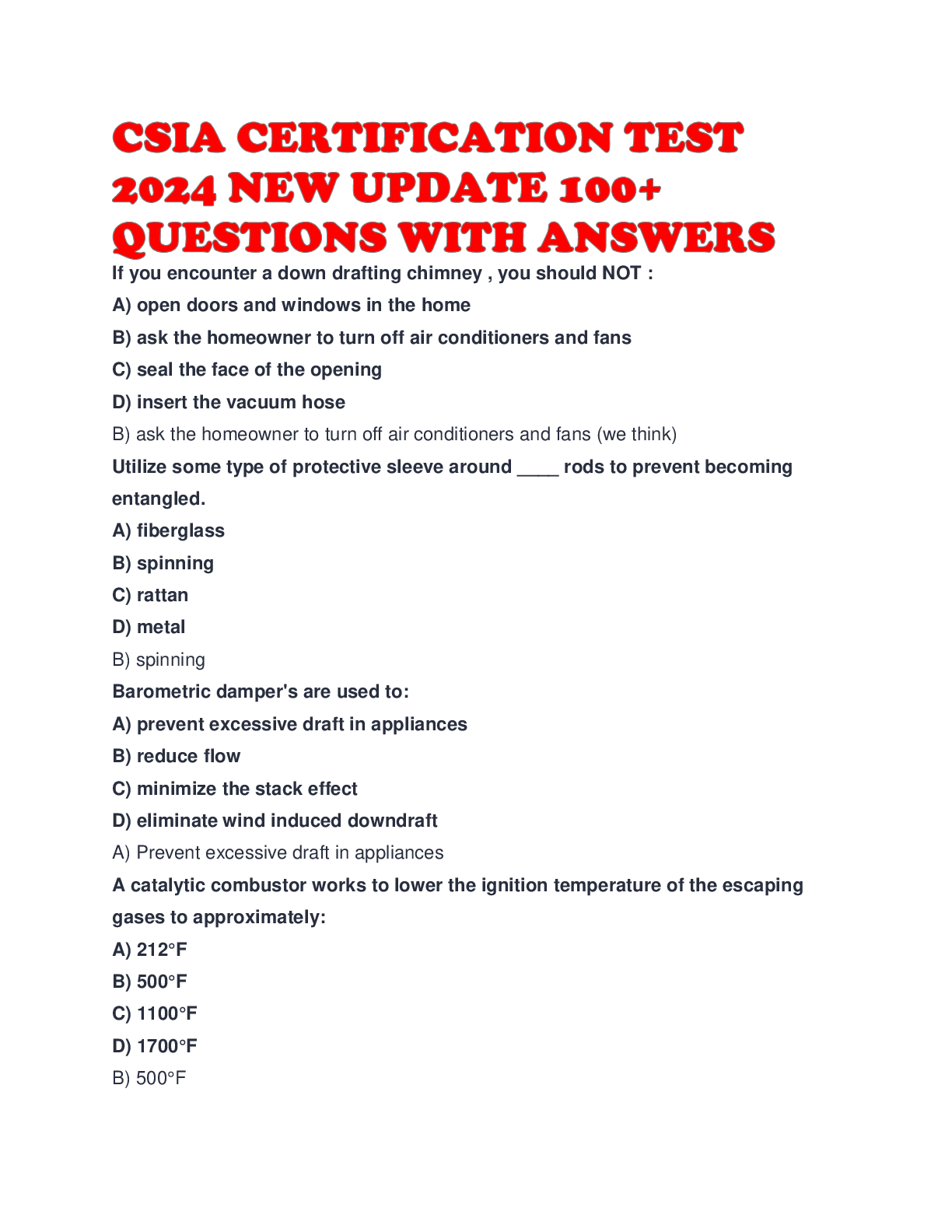
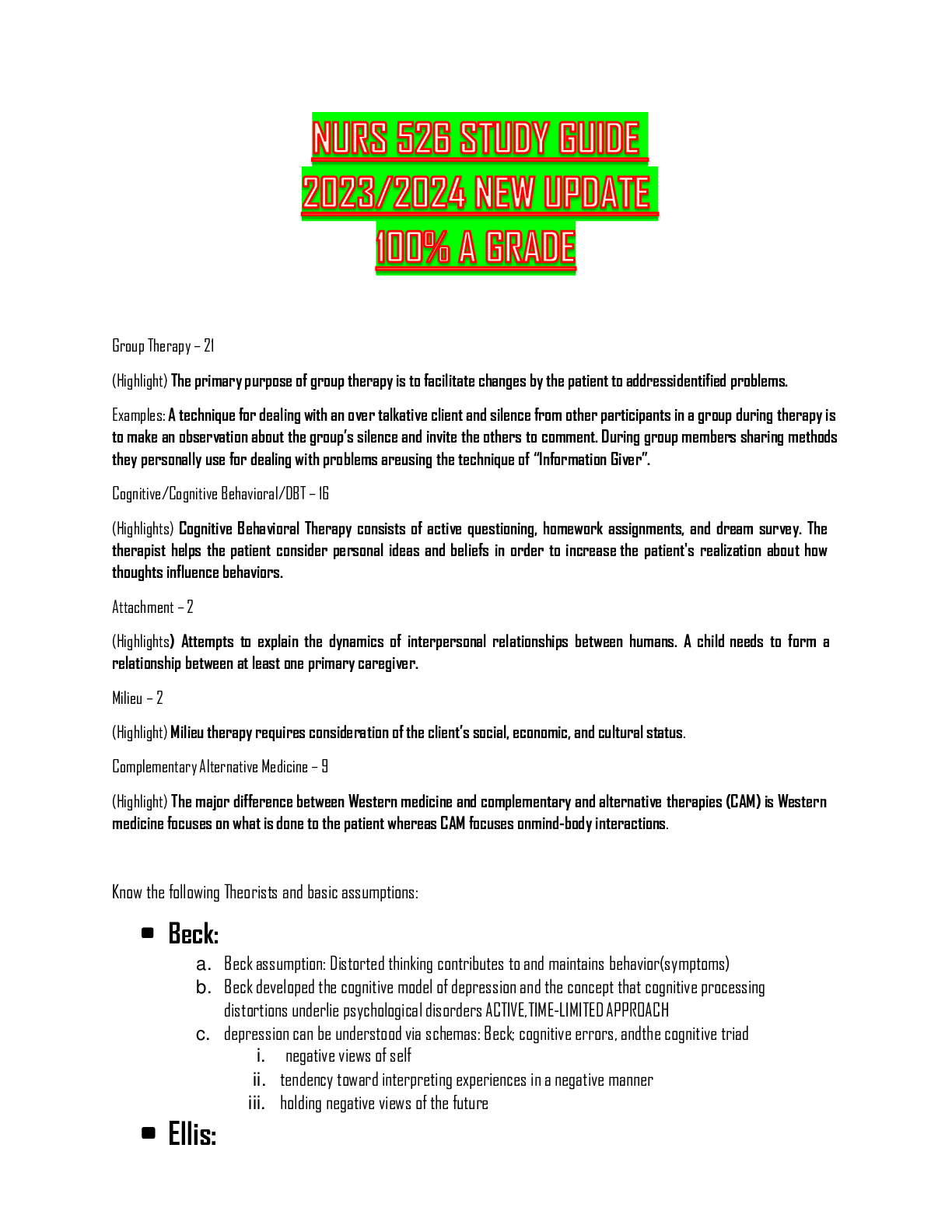

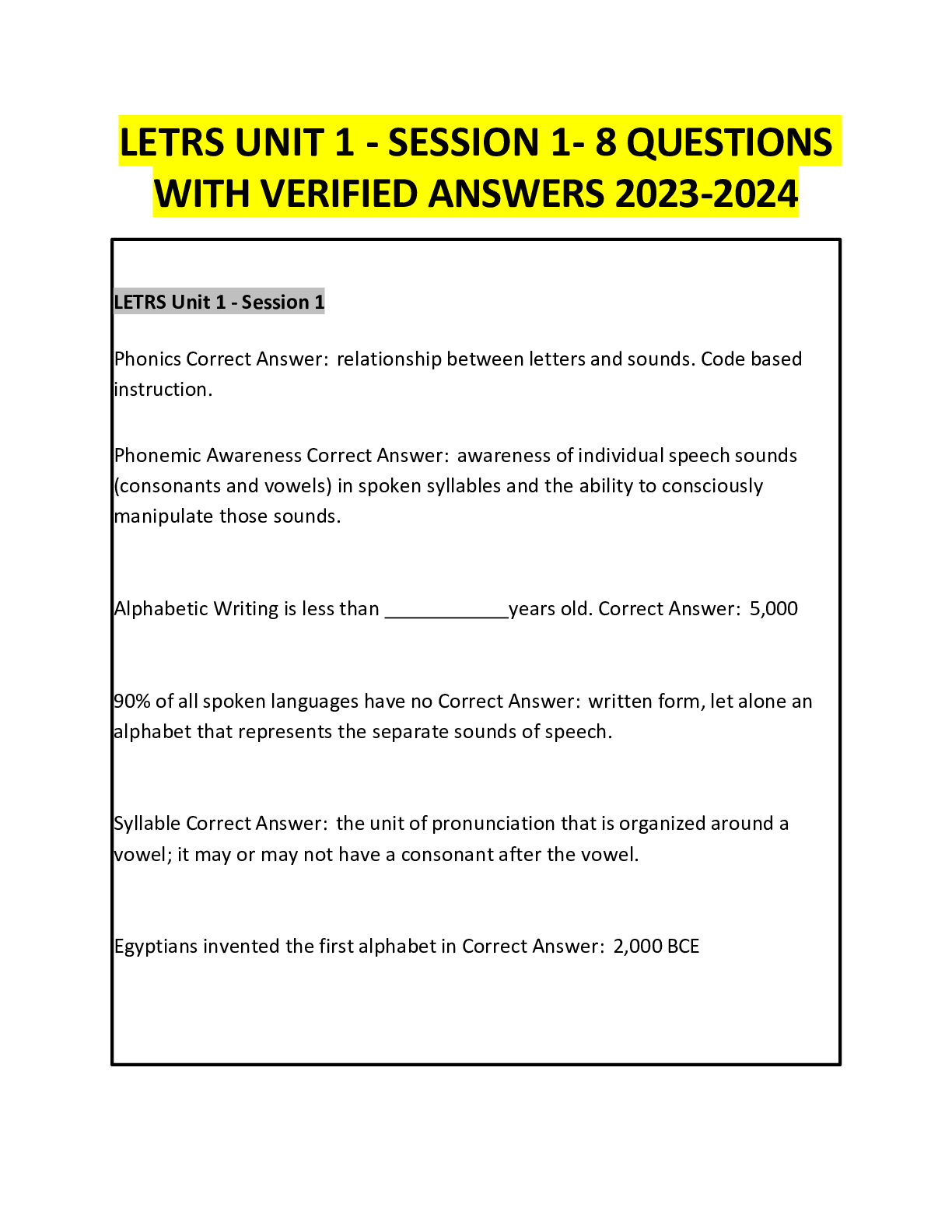

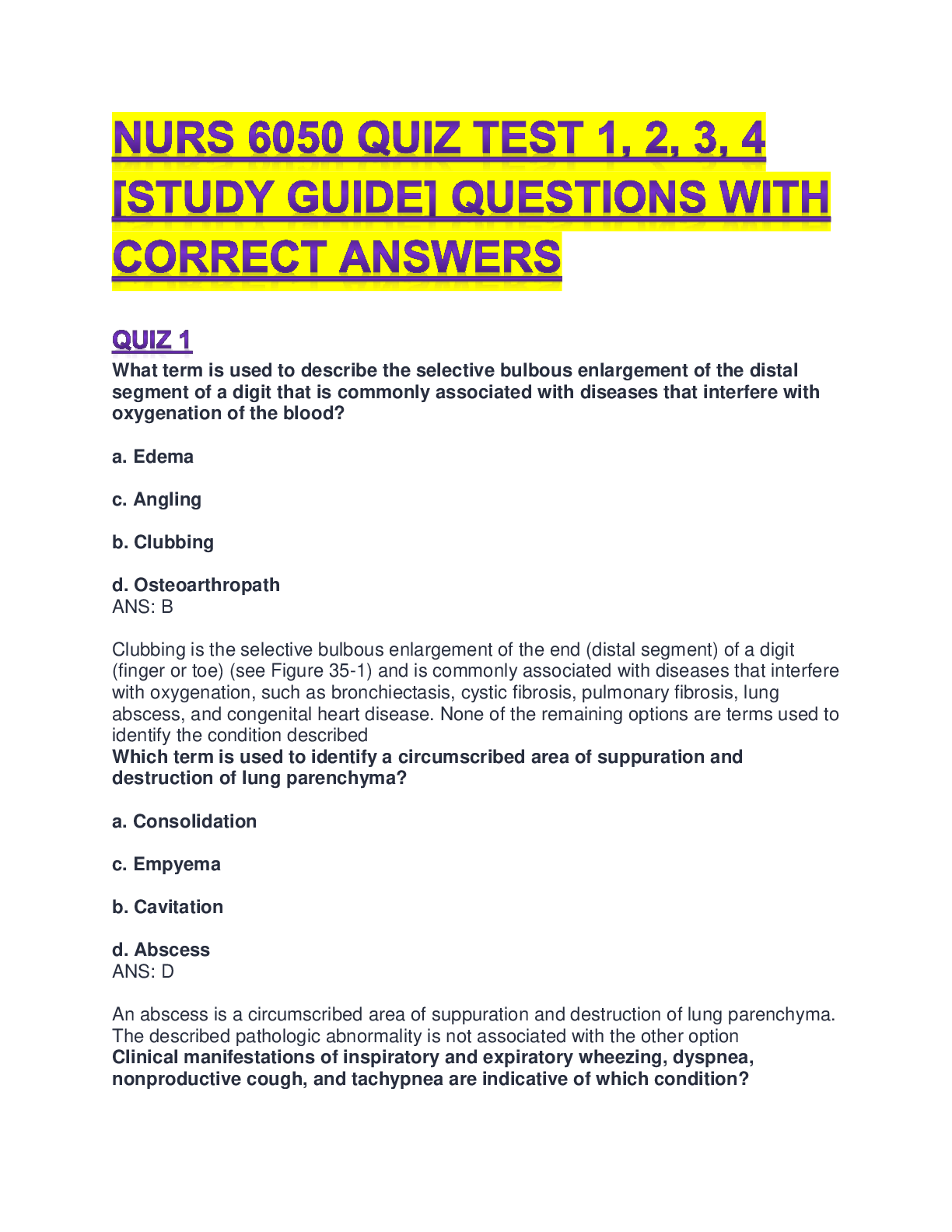

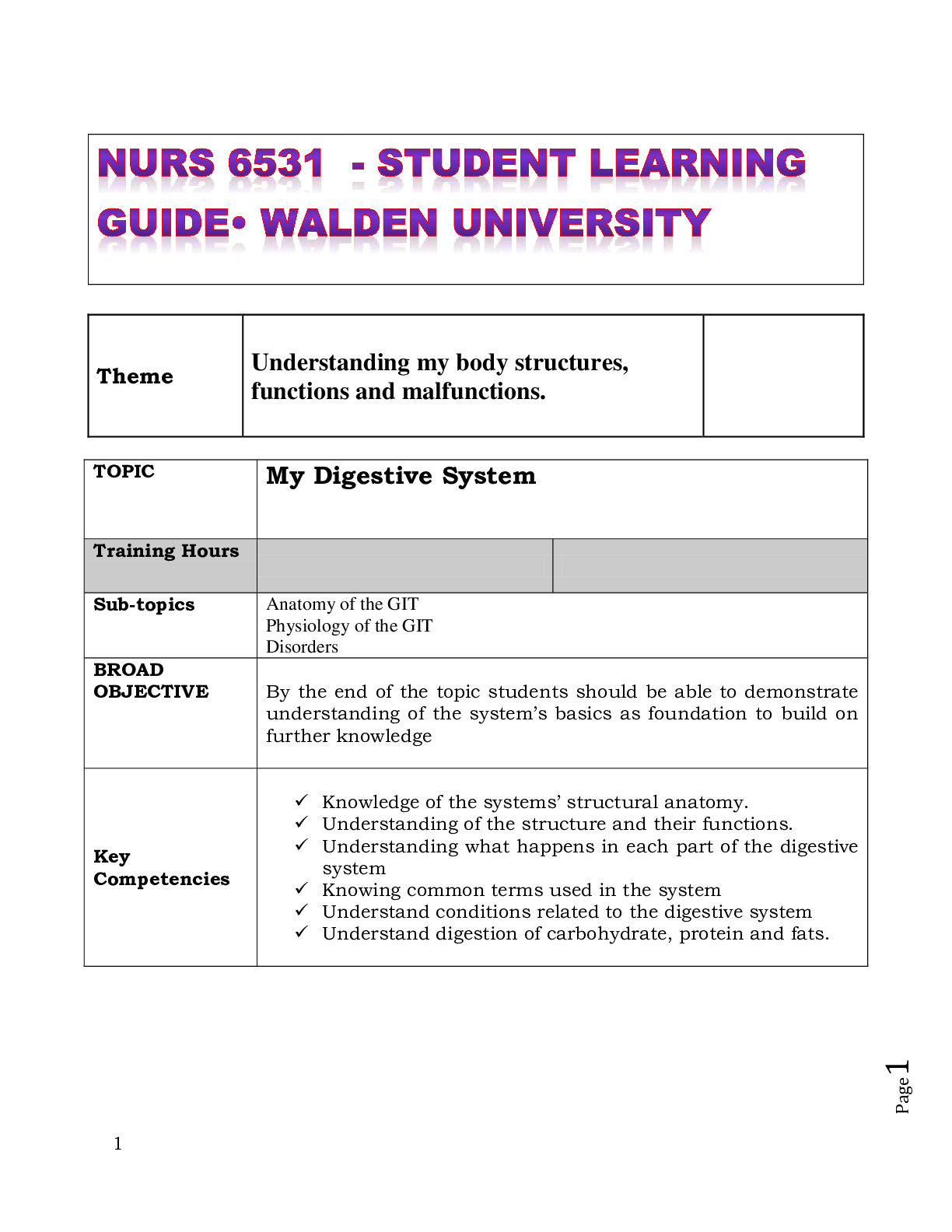

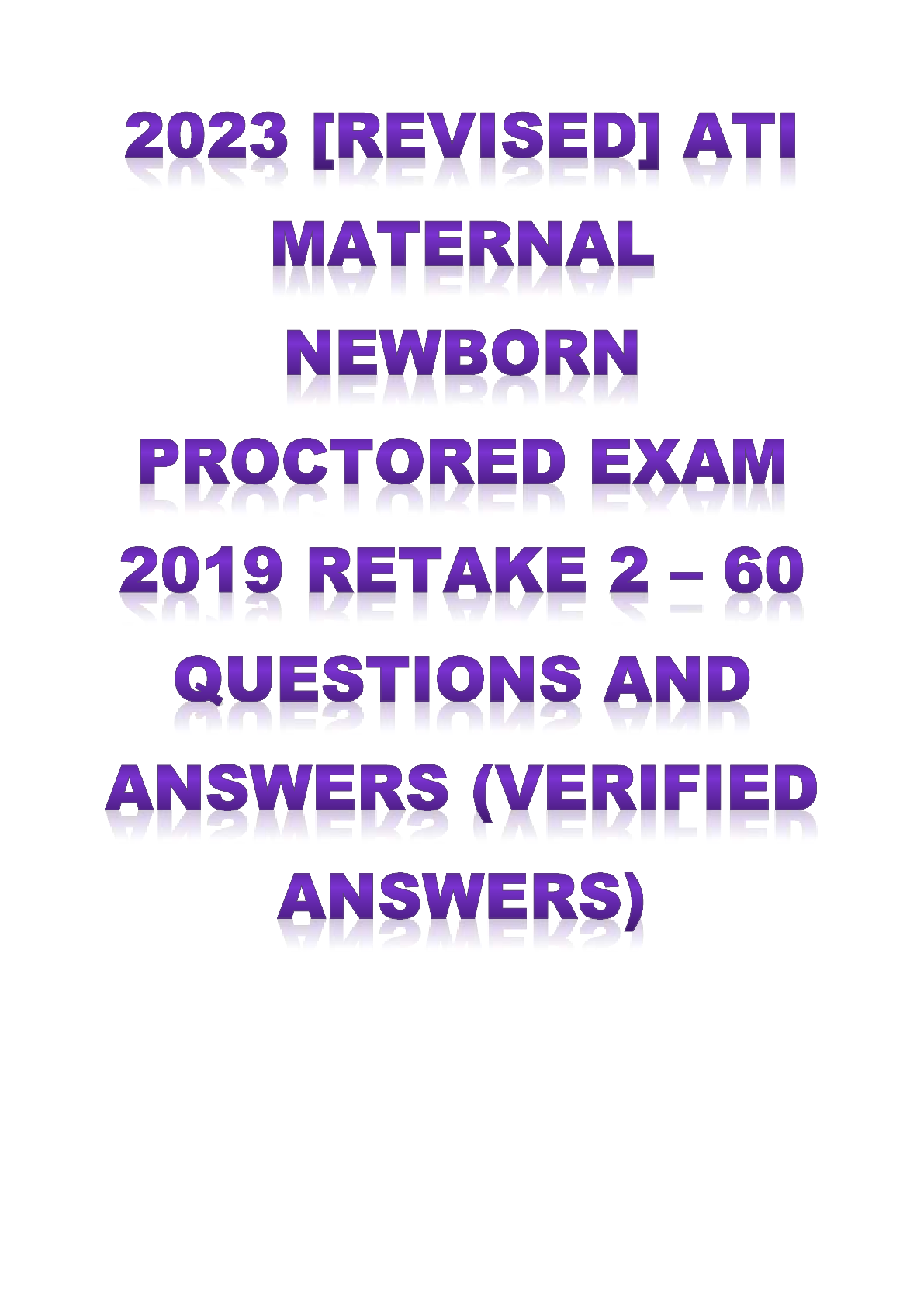
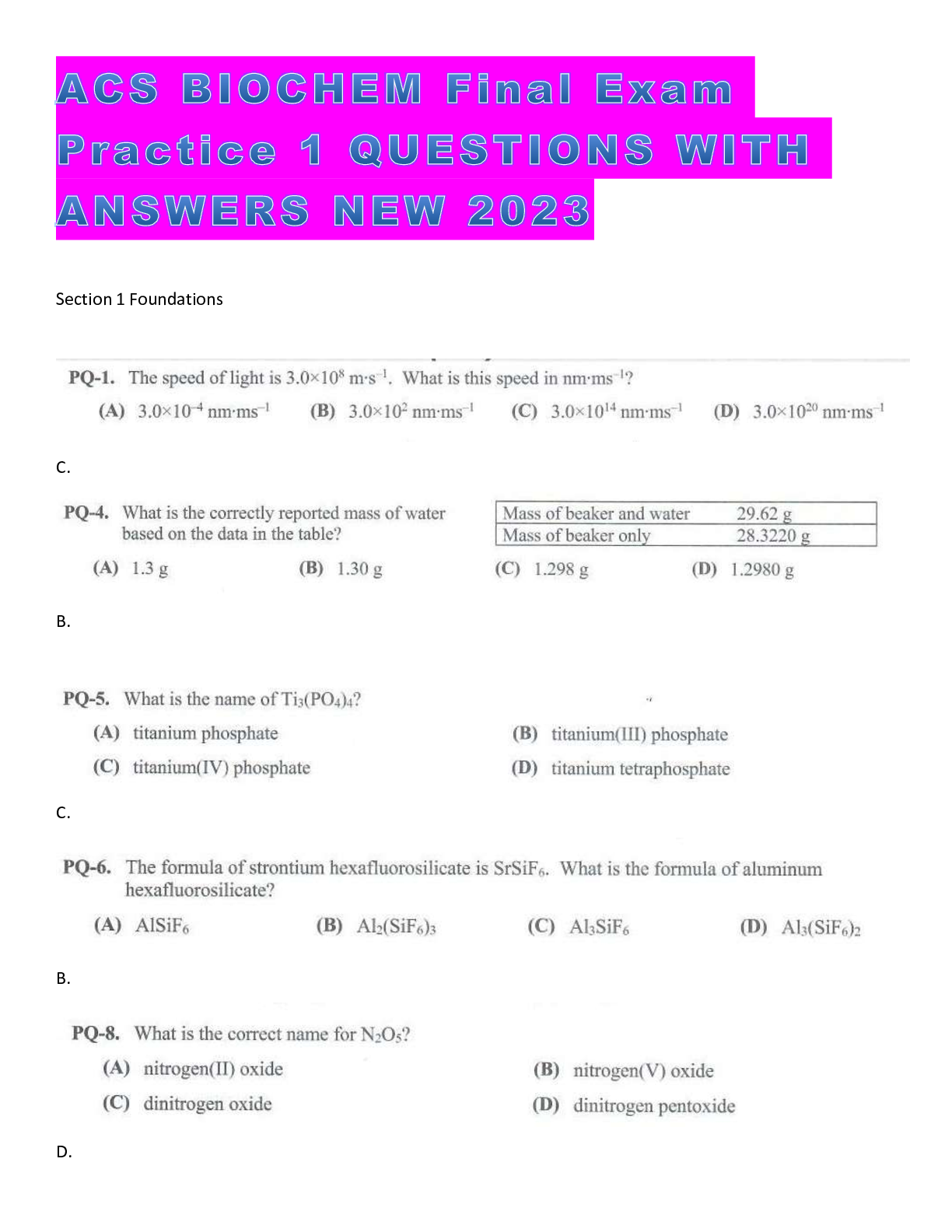
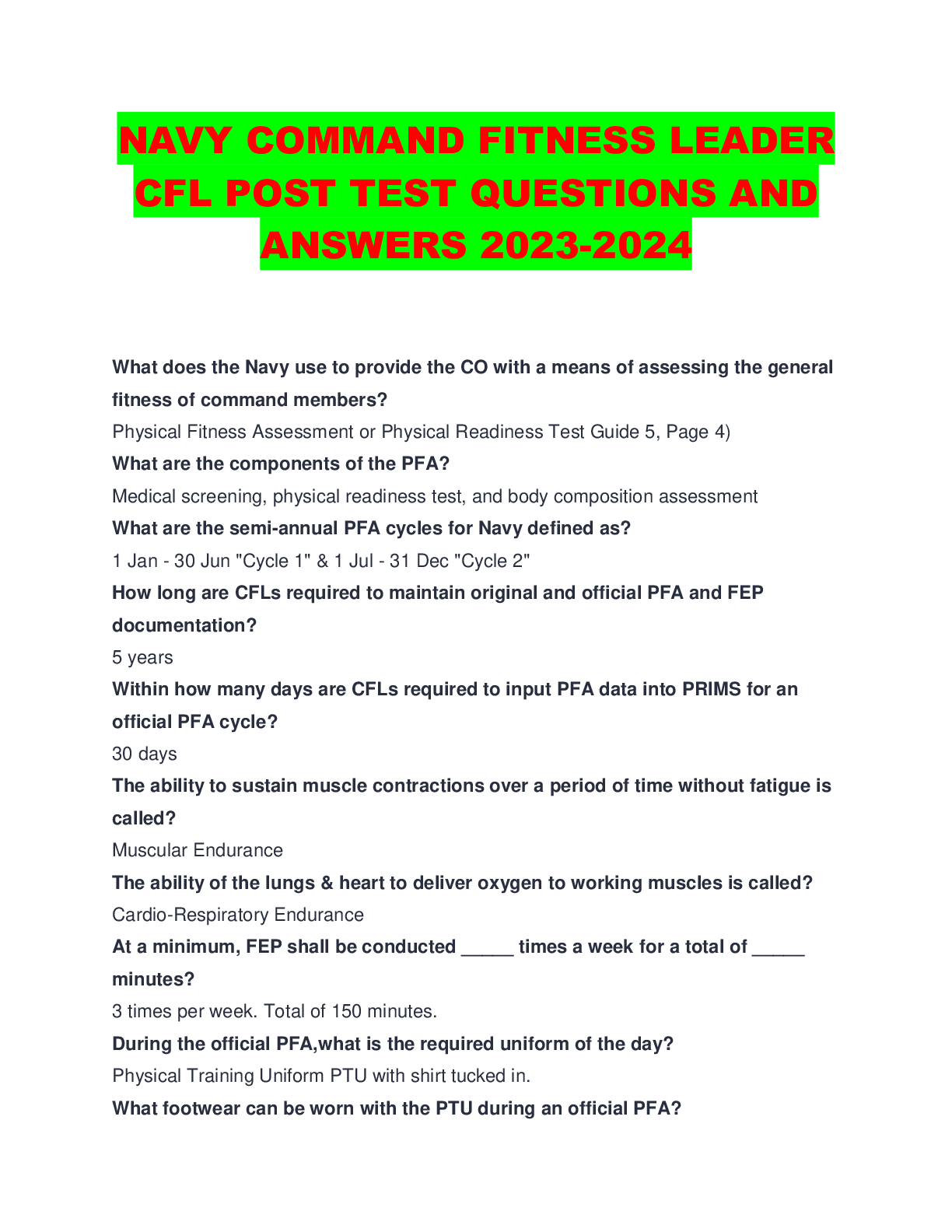

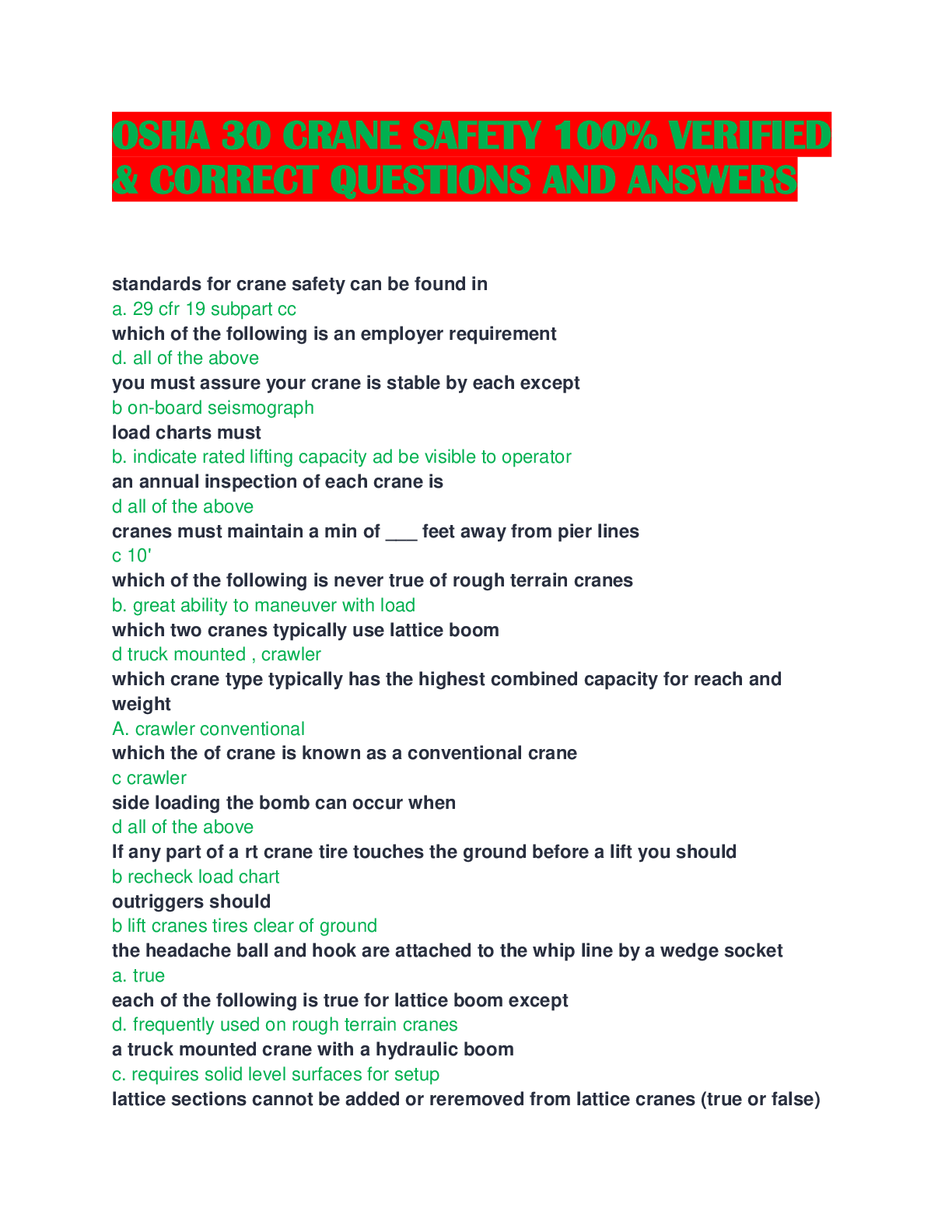





 Rasmussen College.png)
